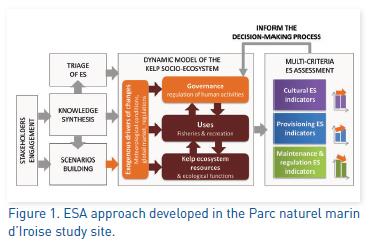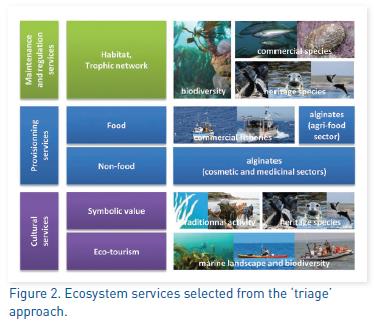The Place and the People we worked with
The Molène archipelago is a shallow area of almost 300 km² which is home to the most diversified algae Laminaria fields in Europe and the most extensive in France. This area is remarkable due to the outstanding natural ecosystem containing dozens of species of algae, marine mammals and birds of national and European significance. The archipelago is included in the Parc naturel marin d’Iroise boundaries, a Marine Protected Area (MPA) created in 2007. This region of the Iroise Sea is also a MPA under the OSPAR convention and a large part of its perimeter is listed under the European Habitats and Birds directives (Natura 2000 network). It is also recognized as a UNESCO Man and Biosphere Reserve.
With respect to kelp harvesting, a dedicated commission of the Comité Régional des Pêches et des Élevages Marins de Bretagne – CRPMEM (Brittany Regional Fisheries Committee) is responsible for defining proposals for the management of kelp exploitation, which are then amended and codified by the State representative. The VALMER Parc naturel marin d’Iroise team mainly worked with stakeholders from this commission.
The Process
Our work in the Parc naturel marin d’Iroise is described in Figure 1. The aim was to assess the current provision of services provided by the Iroise kelp ecosystem and to simulate, with a dynamic model, the fluctuations of service levels according to different management options. The development of this integrated tool was carried out through interconnected processes.
Ecosystem Services Assessment (ESA)
The focus of our study was the intertidal and subtidal kelp habitat of the Molène archipelago. Among species depending on kelp habitats are fisheries resources (e.g. abalone, crustaceans, fish) and species with a high conservation status (e.g. common bottlenose dolphin, grey seal, breeding birds). Kelps are sought by agrifood, pharmaceutical and cosmetic industries for their alginate content. Sixty percent of French kelp production occurs in the Molène archipelago and demand is increasing. The cohabitation of sustainable activities in the Park is an important management issue, as is traditional and cultural heritage conservation. The choice of which ecosystem services to focus on was determined using an innovative ‘triage’ method (Figure 2). Indicators were defined for each service.
Building Scenarios
The exploratory scenarios aimed to compare management options, in the context of various possible changes in the kelp socio-ecosystem. In order to develop a dynamic model able to simulate these scenarios, the case study team first analyzed the exogenous and adaptive drivers of the system.
Kelp management scenarios tested in the VALMER project were real-life scenarios, discussed in the kelp dedicated commission of the CRPMEM. The exploratory scenarios tested aimed to explore with stakeholders the model’s potential and limits, and further refine the scenario building exercise.
Dynamic Socio-Ecological Modelling
Considering the aim of the ecosystem services assessment and the numerous factors of influence which must be taken into account, a dynamic system model for simulating the impacts of various fisheries management options on key ecosystem services seemed to be the most appropriate and useful approach. The first step consisted of building with scientists, managers and stakeholders a conceptual model of the function of kelp socio-ecosystems, including kelp forest functions supporting biodiversity, human activities and the governance system of the whole ecosystem and resources.
On this basis, a numeric simulation model was built, starting with the ecosystem component: a kelp population dynamics model and ecological functions assessment. It was followed by the addition of an economic model of kelp harvesting and by the implementation of harvesting areas access rules.
The Results
As management challenges require consideration of interconnected dynamic processes, the case study team developed a dynamic system modelling approach. It provided a powerful tool to manage highly complex processes despite uncertainties and occasional gaps in knowledge. This work is an on-going, long-term process, and development of the model to show changes in ES provision in relation to scenarios will continue.
Development of a numerical simulation model of the kelp socio-ecosystem
The VALMER project was an opportunity for knowledge synthesis on the kelp socio-ecosystem and to start innovative modelling work. Involving stakeholders in the model development was necessary in order to achieve a better description of many processes. This tool provides new highlights (e.g. the harvestable biomass with respect of plants size and kelp population dynamics, see Figure 3). Knowledge gaps in some areas and existing data accessibility issues prevented us from producing a complete quantitative and dynamic ESA.
Implications for Governance
Ecosystem Services Assessment provides clarity with regards to the benefits received from a given ecosystem and improves transparency regarding trade-offs. During this project, scientists, managers and stakeholders further developed their relationships, shared their knowledge and marine visions. The ES approach is an emerging concept and it was an interesting challenge to involve local stakeholders to accomplish an efficient and operational integrated assessment. Despite the complexity of the model and concepts, it was important to maintain the confidence and involvement of stakeholders during the process by clearly communicating the model’s uncertainties and results.
For further information on the PNMI case study please contact Philippe LE NILIOT philippe.le-niliot@aires-marines.fr

 English
English  Français
Français 










Comments are currently closed for this case study!